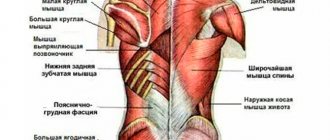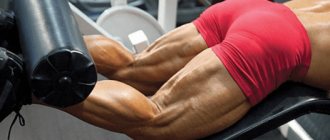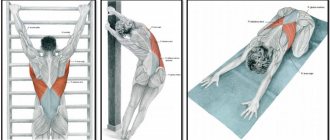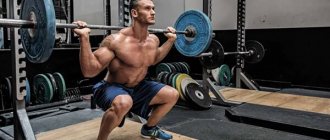Greetings, dear friends, to my sports block sportivs. Alexander Bely is in touch. Today I will tell you about Pilates exercises for the back, lower back and improving stretching. We will look at the basis of Pilates, features, advantages and of course the correct technique.
So, let's first look at the basic concepts of this area of training.
A little history
The world-famous exercise system was invented by John Pilates more than a hundred years ago. It was intended to get rid of back pain, neck pain and even improve posture.
John Pilates developed his training program initially for the rehabilitation of patients who had suffered a spinal injury. But the set of exercises has been loved by thousands of people around the world over a hundred years of existence. Today, the popularity of Pilates gymnastics for the spine is only increasing.
General overview
At the moment, more and more people are experiencing pain in the back and lower back. The main cause of the problem is a sedentary, inactive lifestyle. To prevent pain and strengthen the lower back muscles, I recommend doing a set of exercises two to three times a week.
Before we move directly to the training itself, for people suffering from pain in the back, I offer as a Gift a Free video course “Treatment of lower back pain.”
Gentle, focused exercises will help you achieve excellent flexibility without increasing muscle size. That is why Pilates is most suitable for girls who want to develop the elasticity of their body. To achieve maximum results, such training must be performed regularly. Now let's talk about that very set of exercises.
What is Pilates?
Pilates was invented for the rehabilitation of patients who had suffered an injury, so we can conclude that the set of exercises does not involve excessive loads and is not based on the principle “the stronger the better.” If you perform the exercises according to the instructions, then there is no chance of injury, unlike any other exercise system.
The goal of Pilates is not to build muscle or quickly lose 10 kg. First of all, this is gentle stretching and gentle strengthening of muscles. Just like a hundred years ago, and to this day, Pilates for the spine is considered one of the most highly effective techniques that strengthens muscles.
How to do Pilates with a herniated disc
Focus on body alignment in the program. While lying down, pull your knees towards your chin with force for 10 seconds. As you bend your right leg, straighten your left leg at the same time. Synchronize movements depending on the position of the limbs in space. Keep them suspended throughout the set.
Without changing the IP, place a towel cushion under your spine and place your hands behind your head. As you inhale, lift yourself up and bend your shoulders. As you exhale, return to the starting position and repeat 6 times.
Sitting on the edge of a chair, clasp your fingers at the back of your head.
Gently bend back until your shoulder blades touch the support. As you exhale, bend forward, and as you inhale, bend over. Don’t miss classes, follow the principles of the method, adequately distribute your strength and you will be healthy. Video Pilates for the spine
What's the point?
Like any training program, Pilates has its own principles and rules. The most important of them are the following:
- Concentration is the paramount rule. This principle implies that each exercise should be performed wisely, you need to fully concentrate on the muscle group that this or that exercise is aimed at. One simple rule works here: the higher the degree of concentration, the better the result in the future.
- Without relaxation there is nowhere. This principle tells us that it is under no circumstances recommended to perform exercises while under stress or in a bad mood. No matter how bad your mood is, before training, try to get everything bad out of your head and focus on the exercises for the next hour.
Efficiency of application
You can exercise at home, fitness clubs, and rehabilitation centers. The last option for cervical osteochondrosis is most preferable. Before starting training, the rehabilitation doctor must explain to the patient the basic principles of Pilates. The point of regular exercise is not athletic achievements, but the strengthening of certain muscle groups that will stabilize discs and vertebrae and prevent their displacement.
| Rules to follow during Pilates classes | Characteristics |
| "Rib" breathing | During classes, deep breathing is practiced, allowing you to move with lungs filled with air. It concentrates in the lower part of these respiratory organs, so the anterior sections do not expand, like the abdomen |
| Concentration, separation of body and mind | Physical and mental processes are combined during training. The better the patient concentrates on the muscles that need to be strengthened, the higher the quality of the exercises, and the process itself goes much faster. |
| Center | The energy source zone is the foundation, the main component of training. In Pilates, it refers to the area where the rectus and transverse abdominal muscles are located. It is from this zone that you need to take the energy necessary for training |
| Control and precision | During classes, a certain sequence of exercises is followed. That is, attention is focused not only on the muscles of the neck, but also on the adjacent muscles of the shoulder girdle and chest |
Preparatory stage
Preparation is one of the most important stages in training. Each joint must be in its place during exercise, otherwise there will be no sense in it. Even the slightest displacement can lead not only to pain, but also to serious injuries, such as sprains or dislocations.
Concentration goes hand in hand with coordination. It is necessary not only to focus on the muscles that the exercises are aimed at, but also to constantly monitor the correct execution of these exercises. When the exercises become a habit, coordination will be carried out at a subconscious level.
In other words, a dynamic stereotype will be developed. The exercises are performed “automatically” and at the same time with exceptional accuracy and correctness. The principle of centering is based on the fact that not only the abdominal muscles, but also the abs, take part in supporting the spine. Safe and correct exercise is based on stabilizing the abdominal muscles.
Pilates as a preventive measure
Neurologists and vertebrologists recommend doing Pilates for patients with osteochondrosis of any severity and location, regardless of the cause of its development. It doesn’t matter whether the disease arose due to a sedentary lifestyle or excessive physical activity.
Regular training helps even with already developed complications of osteochondrosis. For example, proper exercise will reduce the size of the hernial protrusion.
Pilates classes are an excellent prevention of not only the progression of cervical osteochondrosis, but also its development.
Who is recommended to take up Pilates?
Since Pilates exercises for the spine are considered one of the safest physical activities, the complex, according to experts, is recommended to be performed in the following cases:
- It is strongly recommended to turn to a set of exercises for those who have suffered a musculoskeletal injury. First of all, ligaments, muscles, bones.
- For diseases of the spinal column and any derivatives from them.
- Exercises are recommended for pregnant women and during the recovery period after childbirth.
- For varicose veins.
- For joint problems caused by excess weight.
- To old people.
- If you lead a sedentary lifestyle, if you have a sedentary job and completely lack physical activity, as well as for those who engage in heavy physical labor. Such exercises will be useful for both categories of people, since they are aimed not only at stretching, but also at relaxation.
- Pilates is suitable for spinal hernia.
- The ideal complex would be for those who have never played sports before, that is, for unprepared people. This may be the initial stage before serious physical activity.
In any case, your back will only be grateful. However, despite the fact that Pilates is considered a gentle complex, if you have serious chronic diseases, it is better to consult a specialist before starting to train.
Exercises to treat hernia
With a diagnosis such as intervertebral hernia, the emphasis in exercises is not on physical or strength training, but on stabilization and alignment of the spine.
Muscle tension occurs evenly, which is gentle on the intervertebral discs. People who have mastered the Pilates technique with this diagnosis stop experiencing severe pain and live a full life.
The technique is as follows:
- Lying on your back with your arms and legs straight, try to pull your socks towards you as much as possible and almost touch your chin to your chest.
- Lying on your stomach, place your hands under your chin. As you exhale, slowly lift your arms, head and chest off the floor while holding your pelvis, legs and stomach.
- Kneeling, hands on the floor. Raise one or the other straightened leg up, holding it in this position for several seconds.
Video Pilates lessons for the back:
Contraindications to classes
Despite the fact that Pilates for the spine is considered one of the safest techniques, it is not recommended to immediately run for the mat. As experts say in their reviews, exercises have a gentle effect on the body, but a complex that is not compiled correctly and does not take into account any chronic diseases can cause complications. The following factors are contraindications to training:
- Acute infections that provoke an increase in body temperature.
- Any serious pain for no reason.
- If there is a risk of bleeding after an injury or surgery.
- If you feel unwell and are in serious condition during the period of illness.
- A foreign body in the body, usually after injury.
In any case, consulting a doctor won't hurt.
Restrictions are minimal
There are no contraindications for practicing the Pilates complex for the spine, but there are requirements, failure to comply with which may become an obstacle to training.
All exercises must be performed with full mental concentration, thoughtfully and consistently. Be sure to act smoothly, making sure to breathe correctly.
You should immediately stop training if at least one of the exercises causes pain, and then consult a trainer or doctor.
Pilates is a set of exercises for absolutely everyone. There are no contraindications based on age or diagnosis.
The health of the entire body and its functioning largely depends on the condition and endurance of the spine and its muscle group, and this is one of the main arguments for mastering Pilates.
How to achieve a good result?
As reviews show, the effectiveness of exercises depends on proper implementation of the complex and a uniform increase in loads. Even if during the process it seems that everything is easy and simple, do not try to increase the load or speed up the pace of the complex.
As reviews say, if you have health problems, then the supervision of a trainer at the initial stage is necessary. Only a professional will be able to control the correctness of the exercises in order to help correct mistakes on time and show how to do it without the risk of injury. Take your time, study the technique of performing each exercise, study the nuances and subtleties.
Tips for performing the complex
To achieve maximum results without harm to health, it is necessary to correctly and accurately perform exercises to strengthen the back, so Pilates for beginners involves classes in a group or with a personal instructor. If you decide to study on your own, then the video lesson at the bottom of the article will help you.
You also need to follow some simple rules:
- It is advisable to select the complex individually. To do this, you should consult with your doctor, determine the necessary exercises and the number of sessions during the week;
- Each workout should start with simple movements, and then move on to more complex ones. They need to be performed at a slow pace without haste or jerking;
- Do not change the sequence of elements of the complex and perform it strictly according to the program developed by a specialist;
- Before you start exercising, warm up well and warm up your muscles;
- During the training process, carefully monitor your posture and the technique of performing each movement. It is these two factors that play a decisive role in achieving an effective result.
A set of exercises for the spine, legs and buttocks
Experts recommend starting your training with meditation; it is very important to calm down and relax. The main load in this complex is aimed at the abdominal muscles and leg muscles. So, let's start with training:
- Stand straight, feet shoulder-width apart, breathe deeply, with equal intensity as you inhale and exhale.
- Lie on the floor, press your knees to your chest with your hands.
- Pull your stomach in to feel every part of your abdominal muscles and lock them in this position.
- Extend your arms in front of your body, at approximately shoulder level.
- Now, using your abdominal muscles, you need to lower your legs to the floor. Next, smoothly turn your knees to the right and fix them in this position.
- Pull your stomach in again to feel the work of your abdominal muscles, tighten your stomach as much as possible. There must be at least 3 such cycles.
- Lower your feet back to the floor and turn your knees to the left side, locking them in place. Do not forget to control the tension in your muscles, breathe smoothly and evenly.
Now you can move on to exercises on the spine.
Rules and tips
The Pilates method involves 3 types of exercises:
- on the floor;
- using special equipment;
- using simulators.
The general rule for all training is careful movements without pauses. Each of them gradually passes into the other, at this moment the muscles warm up, stretch, and become more elastic. Experts advise:
- choose light clothing for exercise that does not restrict the body;
- do not wear shoes, since contact of bare feet with the floor improves blood circulation and activates points that are responsible for the function of internal organs;
- during the training process, do not throw your head back, but keep it at body level;
- before you start doing the exercises, you need to learn how to breathe correctly, tensing your lower abdomen and filling your lungs with air;
- During exercise, you need to constantly stretch the spinal column, increasing the distance between the vertebral discs.
A set of back exercises
When performing such a complex, you need to especially monitor your breathing and muscle tension. Is it possible to do Pilates if you have a herniated disc? The answer is clear - it is possible. However, this must be done very smoothly and carefully:
- Stay on the floor, pull your stomach in again and tighten your abs, straighten your legs and pull your toes towards you. Take a deep breath and slowly lift your spine up until you find yourself in a “sitting” position, but so that the main load falls on your abs. It is important to feel every vertebra.
- Now you need to continue to slowly reach for your feet until you reach the point where you feel discomfort. Stay in this position for literally 2-3 seconds and slowly lower back to the floor until you are lying on the floor again.
- Do not forget that the abdominal muscles should be tense throughout the entire exercise and the stomach should be retracted.
- When you hit the floor again, bend your knees and keep your feet parallel.
- Now we smoothly lift the pelvis up, we also need to make sure that the spine comes off the floor. Lock in this position for 2-3 seconds. Remember to take deep breaths. This Pilates exercise is perfect for a herniated lumbar spine.
- Return to the starting position, legs remain straight, relax, releasing tension in the muscles. Pull your stomach in so that your navel is literally glued to your spine. Now slowly pull your toes towards you so that your heels do not leave the floor. At the same time, pull your head forward, trying to reach your chin to your chest. Hold the position for 2-3 seconds. Don’t forget to breathe evenly and stop doing the exercise if you feel any discomfort. This Pilates exercise for a herniated cervical spine is recommended to be performed by specialists, but only after consultation.
- Lie on your stomach, place your hands on top of each other near your chin. Without letting go of your chin, try to lift them together with your head and chest as you exhale. Remember to keep your lower body in the original position.
This complex is usually recommended for a sore back. An important rule is smooth, slow execution, but without long stops. If you experience any pain, you should stop training and consult a doctor.
Exercises with equipment
Such complexes are sometimes called methods for perfect posture. In some cases, they are supplemented with elements for the development of the chest or arm muscles and other parts of the body. To perform the exercises, you need to use additional equipment:
- Dumbbells. You need to stand straight, take light dumbbells in your hands. The limbs are raised at right angles at the same time or one at a time, then the training is complicated by slight bends forward.
- Elastic tape. Lying on your side, the tape is secured to your thigh so that your foot rests on it. The limb is extended one by one, overcoming the resistance of the tape.
- Ball. You need to lie on a special ball and make moderate movements to the sides. Training on the ball can also be done in a sitting position, raising your arms up and performing actions that resemble stretching.
Reviews
Ira, 27 years old : I went to Pilates with a friend for company. Before the first training, the instructor asked about chronic diseases, I said that I had cervical osteochondrosis. She performed a separate complex specifically for my diagnosis. After 6 months of training, I noticed that headaches became much less frequent and my sleep improved. I recommend.
Alisa, 19 years old: Upon entering college, we noticed cervical osteochondrosis in the early stages. The doctor advised me to take up some kind of therapeutic exercise, so I went to Pilates. At first it was difficult to control my breathing, but I gradually got used to it. A few months later, at a follow-up examination, they said that they did not see osteochondrosis.











